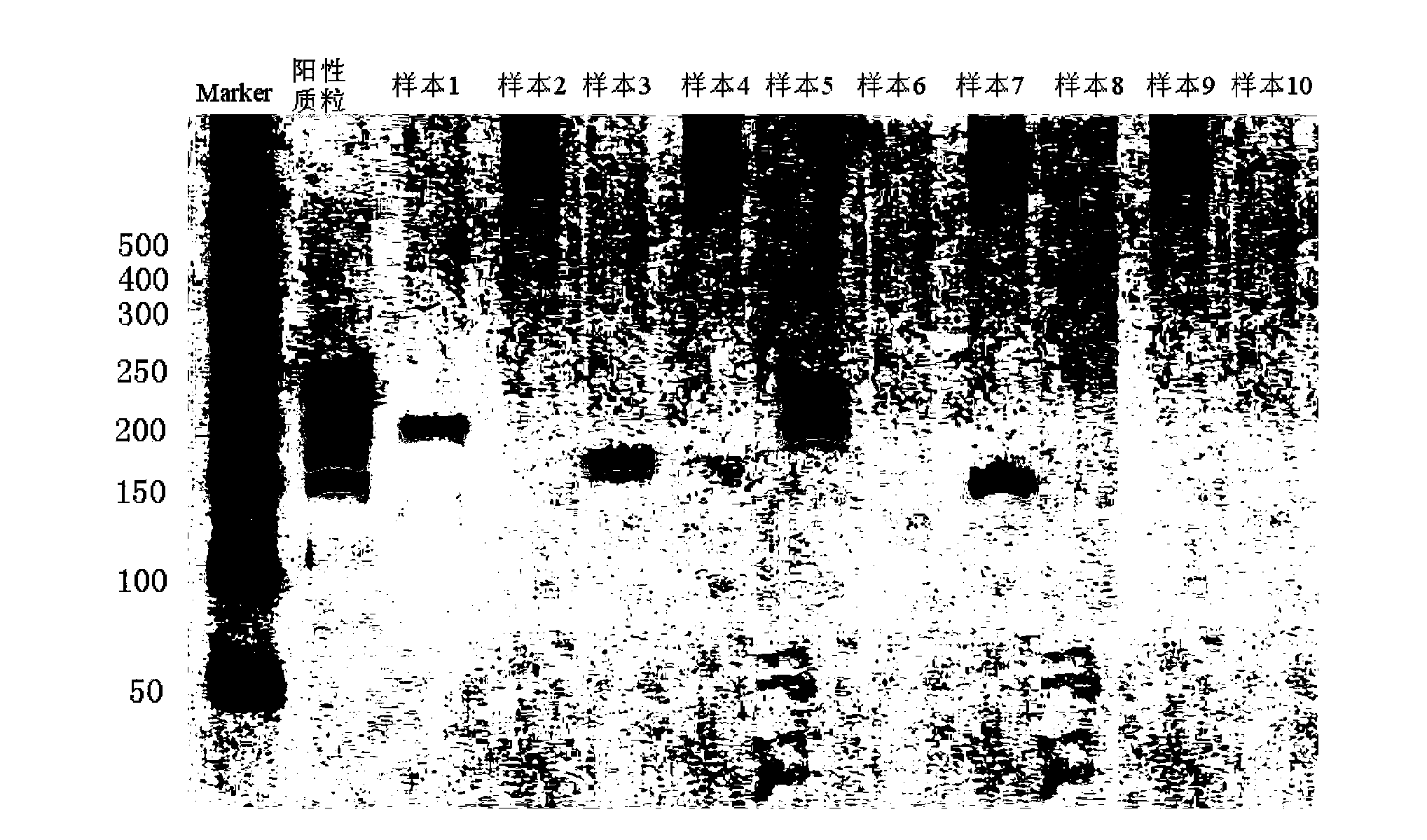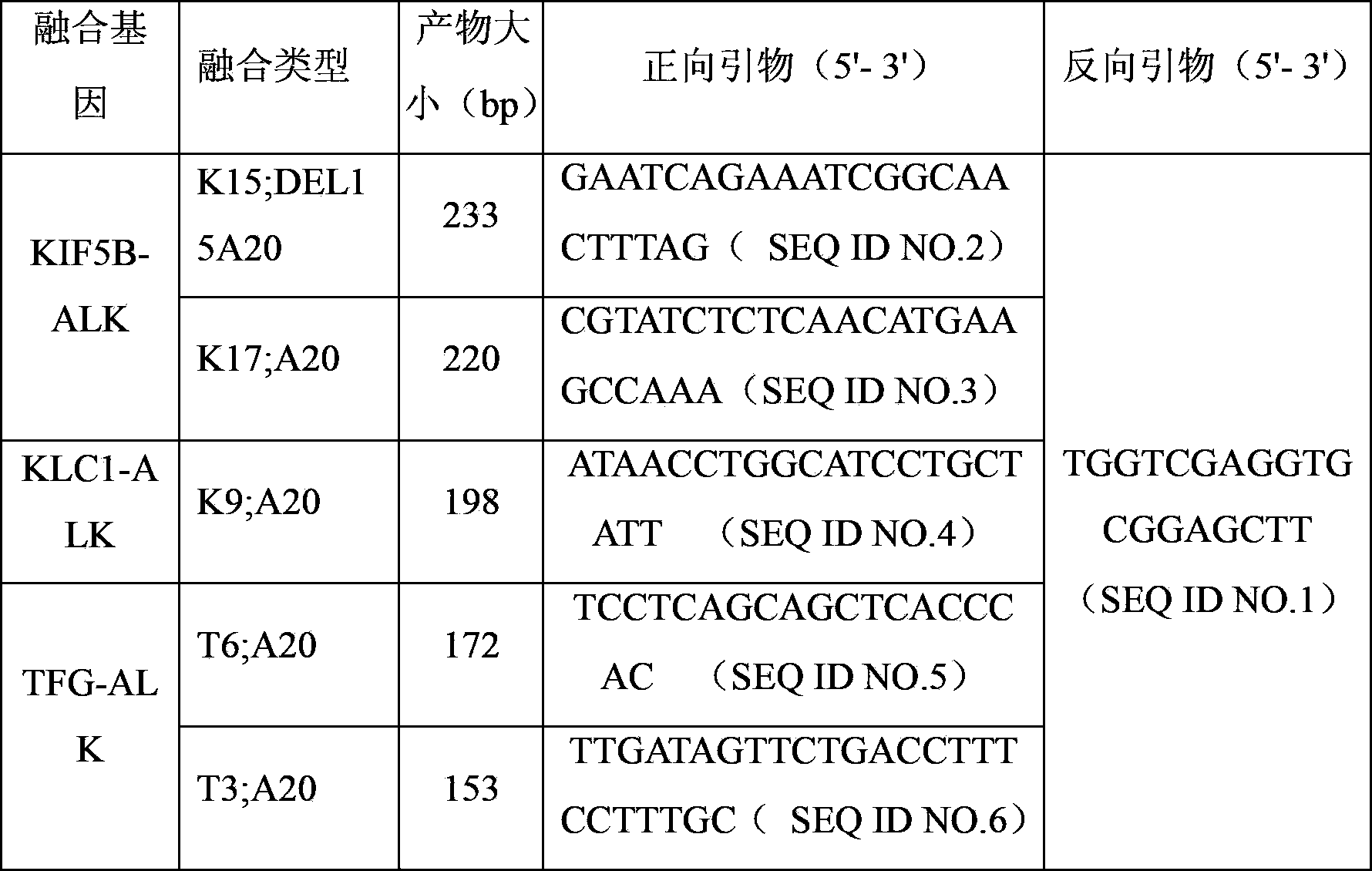PCR (Polymerase Chain Reaction) primer, kit and liquid phase chip for detecting ALK (Anaplastic Lymphoma Kinase) fusion gene
A technology of fusion gene and liquid phase chip, applied in the field of molecular biology, can solve the problems of inability to accurately obtain the fusion type, time-consuming and laborious, and low sensitivity, so as to improve the detection accuracy, overcome low sensitivity and preciseness Analyzing the Effects of Features
- Summary
- Abstract
- Description
- Claims
- Application Information
AI Technical Summary
Problems solved by technology
Method used
Image
Examples
Embodiment 1
[0034] Embodiment 1 A kind of PCR primer and positive control substance detected by the fusion gene detection of ALK fusion gene
[0035] 1. RT-PCR amplification
[0036] 1. Reverse transcription
[0037] For the KIF5B-ALK, KLC1-ALK, and TFG-ALK fusion gene subtypes detected by various targets, the present invention first uses random primers to reverse-transcribe the target detection samples, and reverse-transcribes the mRNA in the samples into cDNA. For specific experimental steps, refer to "Molecular Cloning Experiment Guide", the use of random primers for reverse transcription of mRNA is a routine procedure.
[0038] 2. PCR amplification
[0039] The fusion types in Table 1 are the five ALK fusion gene subtypes detected by the target of the present invention. According to the nucleic acid composition characteristics of the fusion gene sequence, the forward primer and reverse primer were designed using Primer5.0. Using the cDNA obtained in step 1 as a template, the 5 targ...
Embodiment 2
[0050] Example 2 uses PCR primers to detect ALK fusion gene in Example 1
[0051] 1. PCR amplification
[0052] Use the PCR amplification primers described in Table 1 to perform PCR amplification on the mRNA reverse transcription product of the target detection sample and the positive control substance to realize the parallel amplification of the target sequences of the five fusion gene subtypes, and to amplify the five fusion gene subtypes in one step. The strip contains the target sequence of the fusion gene subtype, the product size is shown in Table 1, and the amplification primer sequences (SEQ ID NO.1~SEQ ID NO.6) are shown in the above Table 1.
[0053] First, prepare the PCR primer working solution: take 100ul of the primer stock solutions of SEQ ID NO.1~SEQ ID NO.6 respectively in 1.5ml microcentrifuge tubes, and mix well to obtain the multiplex PCR primer working solution. The multiplex PCR reaction system is as follows:
[0054]
[0055] The PCR amplification p...
Embodiment 3
[0059] Example 3 A liquid chip for detecting ALK fusion gene
[0060] 1. ASPE Primers
[0061] Specific primer sequences designed for target detection KIF5B-ALK K15; DEL 15A20, K17; A20; KLC1-ALK K9; A20; TFG-ALKT6; A20, T3; A20 total 5 fusion subtypes. ASPE primers consist of "Tag + specific primer sequence". ASPE primer sequences are shown in the table below:
[0062] Table 3 ASPE Primer Sequence (Specific Primer Sequence)
[0063]
[0064] Table 4 ASPE primer sequence (tag sequence)
[0065] serial number
[0066] 9
[0067] Each ASPE primer consists of two parts, the 5' end is a specific tag sequence for the anti-tag sequence on the corresponding microsphere, and the 3' end is a mutant or wild-type specific primer sequence (as shown in Table 3 above). All ASPE primers were synthesized by Invitrogen. Each synthesized primer was prepared into a stock solution of 100 pmol / mL with 10 mmol / L Tris Buffer.
[0068] 2. Microspheres coated with anti-tag...
PUM
 Login to View More
Login to View More Abstract
Description
Claims
Application Information
 Login to View More
Login to View More - R&D
- Intellectual Property
- Life Sciences
- Materials
- Tech Scout
- Unparalleled Data Quality
- Higher Quality Content
- 60% Fewer Hallucinations
Browse by: Latest US Patents, China's latest patents, Technical Efficacy Thesaurus, Application Domain, Technology Topic, Popular Technical Reports.
© 2025 PatSnap. All rights reserved.Legal|Privacy policy|Modern Slavery Act Transparency Statement|Sitemap|About US| Contact US: help@patsnap.com



